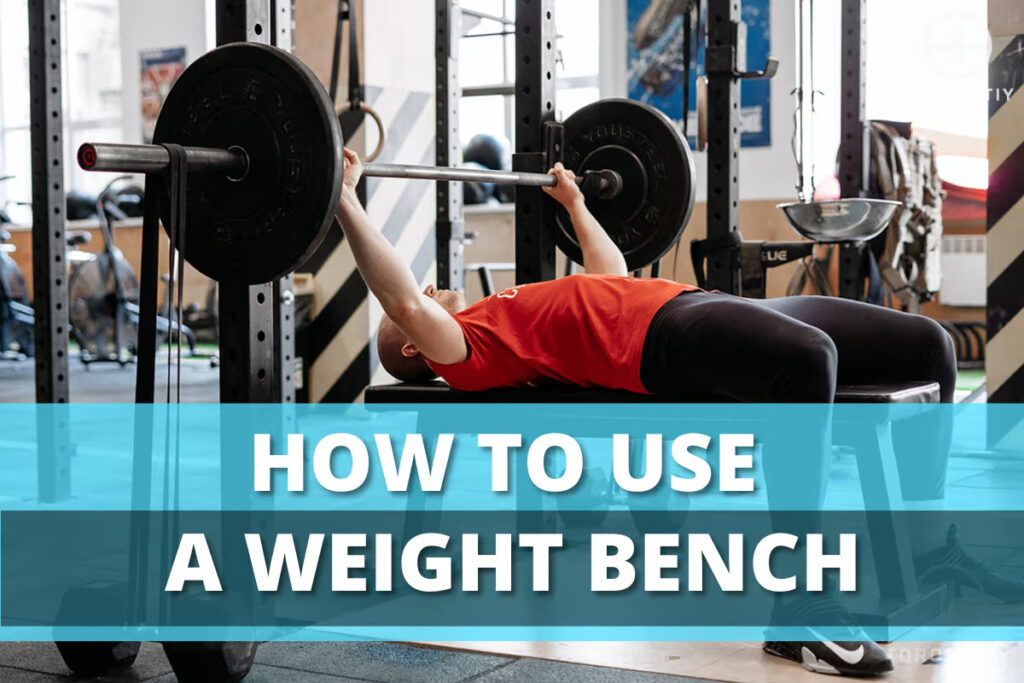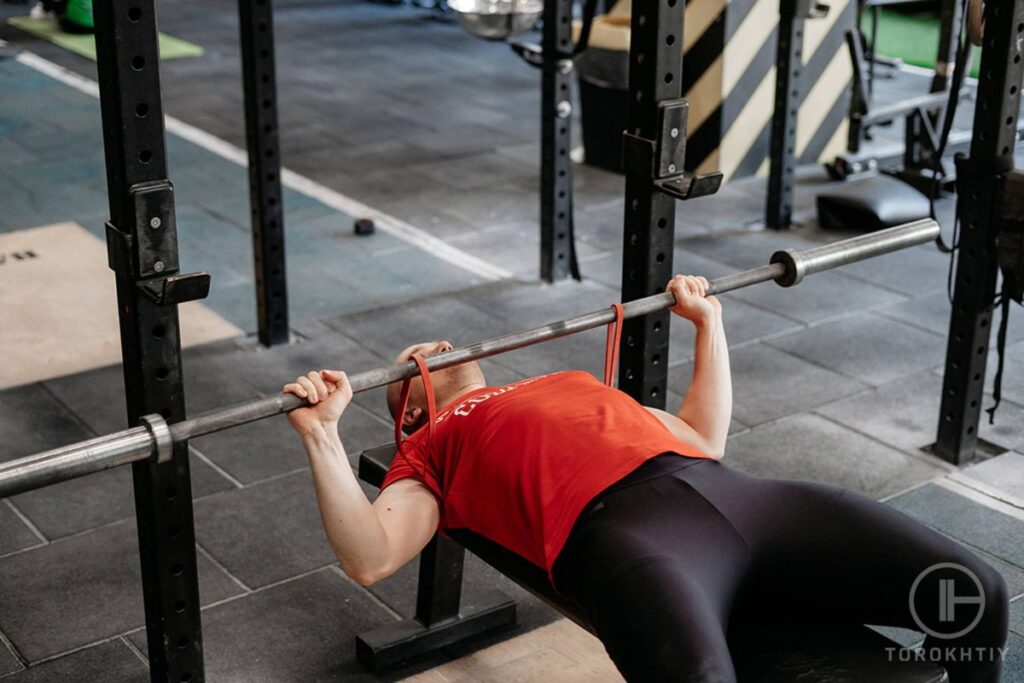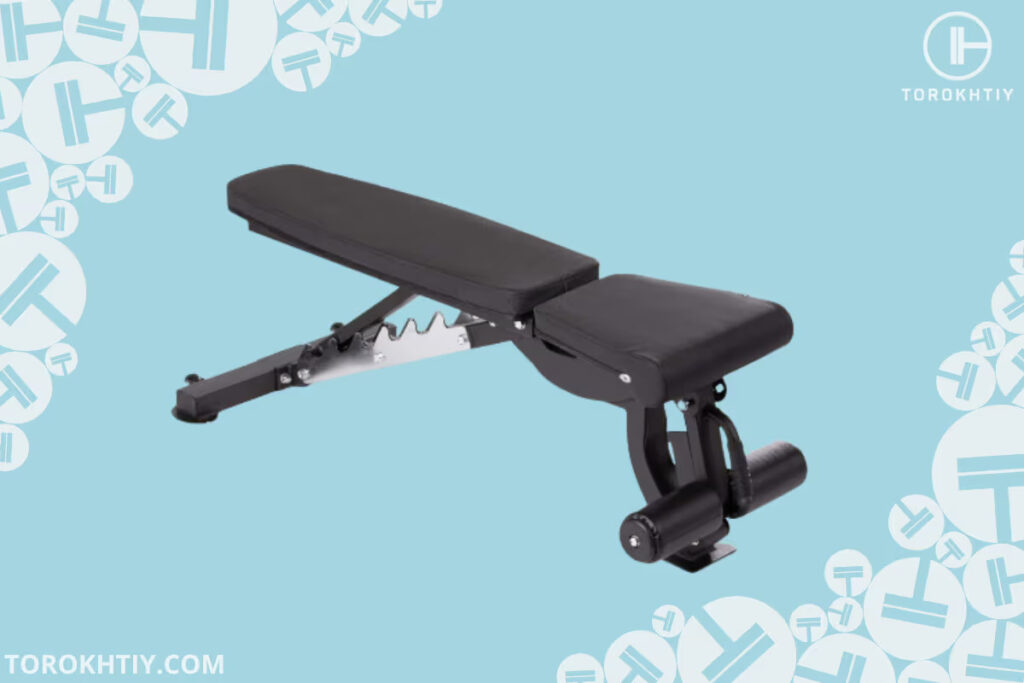How to Use a Weight Bench: 3 Main Rules to Follow
Author:
Reviewed by:
(21 years of Oly Lifting experience)
Unlock your full potential by engaging with our experts and community! Have questions about your fitness journey or looking for expert advice on weightlifting techniques? Don’t hesitate — leave a comment below and Ihor Shymechko will provide a personalized answer and insights to help you reach your goals.
Torokhtiy is reader-supported. Some links are affiliate links, and we may earn a commission at no extra cost to you. See our disclosure page for details.
A weight bench is a valuable and versatile training tool for building muscles, which can be utilized as a compound exercise machine that mostly targets the upper body. Despite its simplicity, you should know how to use a weight bench correctly to benefit from it and not get injured.
You can lie on your back on a bench placing it flat to press the weights (bars, kettlebells, dumbbells) upward. Or it’s possible to adjust the angle and keep the bench at the incline or decline position. Also, reverse flies would be performed with your stomach and chest against the back of the bench.
It’s up to you to choose the position that will fit you most and it also depends on the upper muscles you want to work out and restore your muscle balance.
Asking about how to use a weight bench to work out your upper body? You can place the training tool flat, in decline, or incline position at different angles, and use it together with other supplementary equipment.

How to Use a Weight Bench – Step-By-Step Guide and Safety Precautions?
Despite being a piece of simple gym equipment, a weight bench is also one of the most versatile tools. You can add it to your home gym and quit using a chair to do exercises on your upper body. But, the majority of beginners face the issue of how to use a workout bench and how the position may influence their training.
A weight bench enables you to control your exercise performance by bringing more versatility to your training routine. It creates a solid base for strengthening and toning your upper body.
You’ll build up your chest, namely pectorals, arm, and shoulder muscles. Although the targeted muscles may vary depending on the exercise variation you perform. So, you’ll be able to activate pectoralis major, anterior deltoid, triceps and biceps brachii, and traps.
An adjustable weight bench allows you to move properly while performing any exercise and provides the necessary support for activating specific muscles. Moreover, you can apply it to do conventional exercise variations to diversify your training and involve your muscles in different ranges of motion.
Before using a weight bench, you need to adjust it considering the exercise type you plan to perform, meaning switch between different inclines or declines, and also collect equipment, i.e., a dumbbell, kettlebell, or a short bar.
Follow these steps on how to adjust a workout bench before taking up exercising to get maximum comfort and not limit your range of motion:
1. Move the Bench Into Position and Gather the Equipment
Before adjusting the bench into the proper position, find an appropriate place you can train on this equipment without interfering with others. Then, you need to manage its overall position by placing the backrest. You should adjust the pin correctly that is located on the reserve side of the back. Lift up the back pad with one hand and tug the pin with the other to secure the bench in the needed position. Move the backrest until the pin finds the hole and clicks into it. Check whether it’s locked safely.
2. Set bench position
Make sure to tune your bench inclination to the correct position to target the needed muscles properly. Some exercises like barbell rows, dumbbell bench press, or flat dumbbell fly, may require a flat position to protect your back, while others can be performed at diverse bench angles. Set it up properly to avoid injuries.
Exercises like seated lateral raises and seated dumbbell shoulder press require placing the bench at 90 degrees. While for the decline dumbbell pullovers and decline dumbbell curls you need to change the bench position to the decline one.
Additionally, you can use a weight bench as a piece of accessory equipment to do bodyweight exercises like bench tricep dips, Bulgarian split squats, bench dips, seated crunches, and GHD sit-ups.

3. Brace Against the Bench
When working out on the weight bench, try to keep the right body form and choose proper weights. Don’t push yourself too hard at the start, get used to this type of training and increase the load gradually. Choose the starting weight you can lift for at least 10 repetitions. Use the bench as a supporting tool.
For example, when performing dumbbell fly, dumbbell/barbell pullovers, or bench presses you should keep your feet flat on the floor and your back straight on the bench. Don’t lift your scapulae up, keep them stuck to the bench.
Make sure you keep your core muscles tight. Don’t arch your back as you lift off the bench. Keep your feet flat on the floor and don’t lift them up.
Tips From the Champ
Titan Fitness-made adjustable FID weight bench offers more than 25 various positions for the seat and backrest, making it possible to switch between flat, incline, and decline options. It has 7 back pad positions and 4 seat positions. Another functional perk is the availability of the feet roller enabling to add more exercise variations at the decline position.
Olympic Weightlifting Champion
7 Main Exercises on a Weight Bench for Beginners
A weight bench is a highly versatile piece of equipment every sports devotee should at least work out on, since it provides numerous options to train not only arms and chest muscles, but also your abdominals and legs. Knowing how to use a weight bench properly, you’ll also engage your lower body and abdominals.
Let’s observe the most popular and effective exercises you can add to your training routine. The list includes exercises with free weights and without by engaging your body weight.
1. Dumbbell Chest Press
It’s one of the most popular weight bench exercises amongst athletes at gyms. The exercise works out middle chest muscles dominantly, namely, the pectorals, so you should use both the bench at the incline or flat position. Be cautious while exercising: without keeping proper form, you can injure yourself. Keep your upper arms perpendicular to the trunk and forearms perpendicular to the ground.
2. Dumbbell Skull Crushers (Lying Tricep Extensions)
To work out your triceps, adjust the bench incline or keep it flat. Take dumbbells, barbell, EZ curl bar or a multi grip tricep bar to strengthen your arms. Avoid taking the weights too down to the forehead since you won’t be able to extend your triceps fully and can get injured. Lie on a flat bench, straighten your arms, and hold the dumbbells above your head. Then, bend your elbows by lowering the dumbbells to the sides of your head. Extend your arms up fully and repeat.
3. Bent Over Single-Arm Dumbbell Row
You can work out your back and shoulders, by adjusting or leaving the weight bench flat. Keep your back straight when doing this exercise. Hold a dumbbell in your left hand, kneel on the bench with your right knee by supporting your body with your right arm. The dumbbell should hang straight down, with your left arm fully extended. Exhale when you pull the dumbbell up to the side of your waist and secure it in such a position for several seconds. Return back and repeat.
4. Dumbbell Incline Chest Press
This is a variation of the dumbbell chest press, but with the bench in the incline position at a 45-degree angle and a 90-degree seat to the bench. So, you’ll be able to work out the upper chest, i.e., upper pectorals, and anterior deltoids of your shoulders.
5. Reverse Fly
This exercise involves the back muscles. Keep the proper form: a straight spine, your neck in one line with your back, while your shoulders are tight and pushed back. To do the exercise lie with your chest on the back of the bench, while your feet are involved for stability on the floor. Your shoulders are about level with the top of the back pad and your arms are hanging by holding the dumbbells with a neutral grip. Move only your shoulders, raise your arms in a semi-circular motion until your arms are parallel to the floor. Keep your elbows slightly bent throughout the movement and squeeze your shoulder blades together at the height of the movement. Then, slowly lower the dumbbells.
6. Decline Dumbbell Bench Press
You’ll activate the chest primarily, as well as the triceps and shoulders. It’s an alternative to the standard dumbbell bench press, but in decline that enables you to work out your lower chest. To start working out you need to adjust the bench to slope downwards.
Lay back keeping the weights close to your chest. Take a deep breath and press the dumbbells to lock out at the top. Slowly lower the dumbbells under control, the handles should be about level with your chest. Touch the chest and push the dumbbells back up to the initial position.
7. Plyometrics Workout With a Weight Bench
Besides common exercises with free weights, you can perform more intensive workouts, like plyo movements, that involve just your body weight. The following exercises are worth your attention if you do want to shape your body:
1. A-Jack Jumps
Straddle a bench and squat to touch it before jumping up explosively. Bring your feet together to hop on the bench, then go back down. As your feet hit the floor, slow your descent so that you don’t slam into the bench. This exercise requires quite good body condition and endurance, so it fits more advanced athletes.
2. Chinese Plank
This is a reverse option of a standard plank. You need to put your upper back on the bench with your heels on a second bench or any platform. Lift into the air, creating a straight line from your shoulders to feet. Hold this ‘flat’ position for as long as possible.
3. Elevated Side Plank With Knee Raises
Lie sideways and place your feet on the bench. Push up your body with one hand against the ground and lift yourself into a side plank. Lift your top foot and move your knee to your chest. Repeat this movement on the other side.
| Bench position | Exercise | Muscles worked | ||
|---|---|---|---|---|
| Upper body | Lower body | Core | ||
| Flat | Barbell/dumbbell row | Lats Rear deltoids Biceps Traps | – | – |
| Incline at 45° | Seated dumbbell curls | Biceps Forearm flexors | – | – |
| Incline at 90° | Seated lateral raises | Side deltoids Rhomboids Traps | – | – |
| Decline | Decline dumbbell bench press | Pectorals Front Deltoids Triceps | – | – |
| Flat (as an accessory tool) | Feet-elevated cross-body mountain climb | involves chest, shoulders, and triceps for stability | Quadriceps Hamstrings Glutes | Abdominals |
| Flat (as an accessory tool) | Bulgarian Split Squats | – | Quadriceps Hamstrings Glutes | Abdominals, spinal erectors |
| Flat | Bicycle crunch | – | – | Obliques Abdominals |
Titan Fitness Single Post Adjustable FID Weight Bench – Weight Bench We Recommend

Titan Fitness-made adjustable FID weight bench offers more than 25 various positions for the seat and backrest, making it possible to switch between flat, incline, and decline options. It has 7 back pad positions and 4 seat positions. Another functional perk is the availability of the feet roller enabling to add more exercise variations at the decline position.
Let’s observe its specs in short: the weight is 71 lb, while the maximum weight capacity is 1500 lb. Sounds impressive. The bench has a tripod construction that enables you to place your feet properly during the training. The dimensions are the following: 56.75” L x 25.25” W x 18.25” (flat position)/ 53” H (upright position).
You’ll be able to perform tens of different exercises and will never get bored working out on this bench. What’s more important, the training tool doesn’t wobble while training and is easily adjustable. You can move it around easily with the help of the front handle below the seat and transport wheels. Overall, you’ll get a durable, high-quality, and versatile weight bench that is worth every dollar spent on it.
FAQ
Should I Use a Weight Bench?
Yes, absolutely you should. A weight bench is a worthy training tool to work out your upper body. Due to its versatility, it can be used for performing numerous exercises. So, athletes of any level can find suitable training options for their fitness levels.
How Many KG Should a Beginner Bench?
Let’s speak about the standard weight bench press: male beginners with a body weight of around 80 kg should lift 54 kg for 1RM. While females with a body weight of 55 kg should aim to lift around 21 kg.
Conclusion
How to use a weight bench isn’t rocket science, but you should know some small key aspects about how to do it properly to provide yourself with good support while lifting weights and perform it carefully without injuries.
Nevertheless, are you not sure about what type of weight bench to choose, or which training accessories to add to challenge yourself? Write your queries below and we’ll tell you many essential tips concerning the selection of this piece of equipment.
Also read:
- Weight Bench Guide
- Best Adjustable Weight Bench
- All In One Home Gym Buying Guide
- Kettlebell Buying Guide
References:
- David Rodríguez-Ridao, José A Antequera-Vique, Isabel Martín-Fuentes, José M Muyor. Effect of Five Bench Inclinations on the Electromyographic Activity of the Pectoralis Major, Anterior Deltoid, and Triceps Brachii during the Bench Press Exercise. International Journal of Environmental Research and Public Health, no. 17(19) (2020): 7339.
- Glass S.C., Armstrong T. Electromyographical activity of the pectoralis muscle during incline and decline bench presses. Journal of Strength and Conditioning Research, no.11(3) (1997):163–167.
- Lauver JD, Cayot TE, Scheuermann BW. Influence of bench angle on upper extremity muscular activation during bench press exercise. European Journal of Sports Science, no.16 (2016): 309–316.
- J Padulo, G Laffaye, A Chaouachi, K Chamari. Bench press exercise: the key points. Journal of Sports Medicine and Physical Fitness, no.55(6) (2015): 604-8.
- Mausehund, Lasse; Werkhausen, Amelie; Bartsch, Julia; Krosshaug, Tron. Understanding Bench Press Biomechanics—The Necessity of Measuring Lateral Barbell Forces. Journal of Strength and Conditioning Research, no.36(10) (2022): 2685-2695.
- Gołaś, A, Maszczyk, A, Pietraszewski, P, Stastny, P, Tufano, JJ, and Zając, A. Effects of pre-exhaustion on the patterns of muscular activity in the flat bench press. Journal of Strength and Conditioning Research, no. 31(7) (2017): 1919-1924.
Why Trust Us?
With over 20 years in Olympic weightlifting, strength training, nutrition coaching, and general fitness our team does its best to provide the audience with ultimate support and meet the needs and requirements of advanced athletes and professional lifters, as well as people who strive to open new opportunities and develop their physical capabilities with us.
By trusting the recommendations of our certified experts in coaching, nutrition, and sports training programming, as well as scientific consultants, and physiotherapists, we provide you with thorough, well-considered, and scientifically proven content. All the information given in the articles concerning workout programming, separate exercises, and athletic performance, in general, is based on verified data.
The product testing process is described in more detail here.
Author: Ihor Shymechko
Pro Olympic Weightlifter, Coach
Best Results: Snatch – 208 kg,
C&J – 240 kg
Ihor has been a professional weightlifter since 1996, boasting over two decades of competition experience. His notable achievements include clinching the European Championship in 2009 and securing a silver medal in the 105kg division at the Senior World Championships in 2011. Ihor represented his country in the 2008, 2012, and 2016 Summer Olympics. After retiring from competitive weightlifting, he transitioned to coaching, leveraging his vast experience to guide athletes who now compete on both national and international stages.
Reviewed by: Oleksiy Torokhtiy
Olympic Weightlifting Champion, PhD in Sport Science
Best Results: Snatch – 200 kg,
C&J – 240 kg
Oleksiy Torokhtiy is a professional athlete boasting 20 years of experience in Olympic weightlifting. With multiple European and World titles under his belt, he has showcased his prowess in two Olympic Games (Beijing 2008 and London 2012). Upon concluding his illustrious career, Oleksiy dedicated himself to coaching. By 2022, he had conducted over 200 weightlifting seminars worldwide. He is the visionary behind an international sportswear and accessories brand known for its motto, “Warm Body Cold Mind.” Additionally, he is an esteemed author and the creator of a series of training programs and eBooks.





Still have questions after reading our article? Unlock your full potential by engaging with our experts and community! Don’t hesitate — leave a comment below and Ihor Shymechko will provide a personalized answer and insights to help you reach your goals.